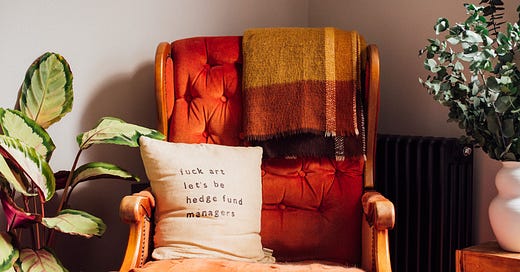One of my favourite things to do before a Zoom call, or in the car before a meeting, or anytime I’m feeling a bit tender, is to imagine a safe and loving energetic bubble around myself.
My bubble reminds me of my edges – of where I end and you begin. It’s a moment of remembering that whatever happens: I’ve got me. This helps me live from a place of being pretty grounded, conscious, and intentional.
It’s a world away from when I lived in the emotional equivalent of an abandoned crack house.
I would leave the door wide open, and everyone was welcome. There was a sign out front: ‘Heartbroken? Existentially bereft? Problematic relationship with authority? Come on in! Leave the detritus of your life all over the floor, stay as long as you want.’
Life in the crack house meant letting in everyone else’s stuff through my porous edges. I gave away all of my energy because I wanted to belong, to be needed, accepted.
Back then, I believed that my needs were not as important as everyone else’s. And so that's how I let everyone else treat me.
Hearing myself say yes when I didn’t want to, turned friendships into a series of obligations. I was so afraid that if I acted for myself, I would get hurt. There was an overwhelming fear that maybe there would be a difficult conversation, even a confrontation. Maybe you would reject me?
At the time, my identity was largely based on my own sad stories (the untimely death of my beloved Mum, my cheating ex-husband, a job that was all kinds of wrong for me). I didn’t know who I would be without all this anger and grief, so I magnetised drama-filled relationships and enmeshed myself in them.
Some of my deepest work has been one of those epic renovation jobs where a complete wreck is slowly restored into something way more light-filled and cosy: from Crack House to Soul House.
That’s where I live these days - in a Soul House where I have unconditional love for myself, a load of compassion, respect and tonnes of self-belief, self-acceptance, self-worth and self-trust. It’s so bloody peaceful. It has not been simple or easy to get here.
The Soul House is the analogy I use all the time for boundaries.
No one is allowed inside - that is sacred space just for me. My beloveds can come up to the front porch. Dearest, trusted would-hide-a-body friends are allowed in the front garden. Outside the gate are people I adore, whose presence feels like an expansion. In my street, the folks I feel connected to are super welcome to hang out.
When the level of intimacy you offer reflects the capacity of the relationship, you can rest in the connection.
This is why I have put some people (metaphorically) on the Moon.
As I get to know you, you are going to show me who you are, and I am going to pay attention. Even the healthiest relationships include differences, disagreements, and mismatches in needs. So at times I may choose to express preferences or share with you what doesn’t work for me. This is what I do to look after myself because I am responsible for loving me.
Boundaries are an expression of the loving responsibility we have for ourselves.
Self-help culture depicts boundary-setting as a cathartic victory: an empowering rush that comes from refusing to put up with an unlikeable person’s toxic behaviour any longer (please can we stop using the word toxic in contexts other than bio-waste?!).
But the majority of boundaries are subtle, nuanced, and occur in our relationships with beloved partners, family members, friends and colleagues: people from whom some emotional distancing can spark everything from mild unease, to heartbreak and grief.
This month’s Self-belief Journalling is about exploring your relationship with boundaries. I’ve found that most of us understandably confuse boundaries with ultimatums, manipulation, and negotiation. But when you start to play with meaningful boundaries, your self-trust and self-worth grow exponentially, and your healthy relationships get deeper and closer.






